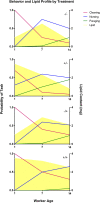Antibiotics in hives and their effects on honey bee physiology and behavioral development
- PMID: 33106276
- PMCID: PMC7710009
- DOI: 10.1242/bio.053884
Antibiotics in hives and their effects on honey bee physiology and behavioral development
Abstract
Recurrent honeybee losses make it critical to understand the impact of human interventions, such as antibiotic use in apiculture. Antibiotics are used to prevent or treat bacterial infections in colonies. However, little is known about their effects on honeybee development. We studied the effect of two commercial beekeeping antibiotics on the bee physiology and behavior throughout development. Our results show that antibiotic treatments have an effect on amount of lipids and rate of behavioral development. Lipid amount in treated bees was higher than those not treated. Also, the timing of antibiotic treatment had distinct effects for the age of onset of behaviors, starting with cleaning, then nursing and lastly foraging. Bees treated during larva-pupa stages demonstrated an accelerated behavioral development and loss of lipids, while bees treated from larva to adulthood had a delay in behavioral development and loss of lipids. The effects were shared across the two antibiotics tested, TerramycinR (oxytetracycline) and TylanR (tylosin tartrate). These effects of antibiotic treatments suggest a role of microbiota in the interaction between the fat body and brain that is important for honeybee behavioral development.This paper has an associated First Person interview with the first author of the article.
Keywords: Antibiotics; Behavioral development; Honeybee; Oxytetracycline; Physiology; Tylosin.
© 2020. Published by The Company of Biologists Ltd.
Conflict of interest statement
Competing interestsThe authors declare no competing or financial interests.
Figures




References
-
- Blaauw B. R. and Isaacs R. (2014). Larger patches of diverse floral resources increase insect pollinator density, diversity, and their pollination of native wildflowers. Basic App. Ecol. 15, 701-711. 10.1016/j.baae.2014.10.001 - DOI
Publication types
MeSH terms
Substances
Associated data
Grants and funding
LinkOut - more resources
Full Text Sources
Medical

